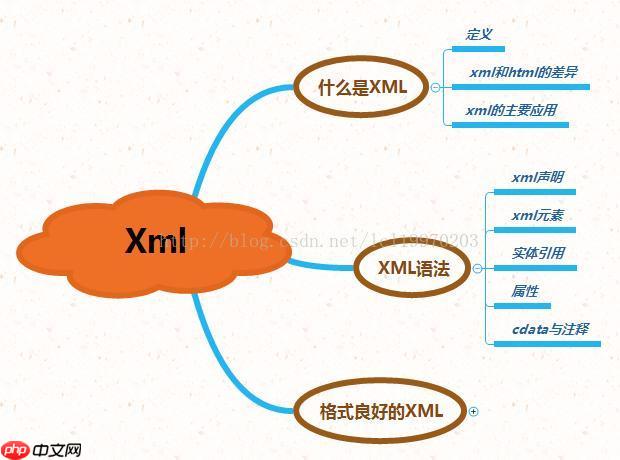xml::libxml是perl中处理xml的核心模块,支持解析、创建、修改和查询xml数据。1. 解析xml时,使用parse_string()处理字符串数据,parse_file()读取文件,二者均返回文档对象,需用eval捕获异常以确保健壮性。2. 查找节点主要依靠xpath,findnodes()返回匹配的节点列表用于操作,findvalue()直接获取文本或属性值,便于数据提取。3. 修改节点包括settextcontent()更新文本、setattribute()设置属性、appendchild()添加子节点、removechild()删除节点,支持动态调整xml结构。4. 创建新文档需调用newdocument()指定版本和编码,通过createelement()构建元素,setdocumentelement()设置根节点,并用appendchild()逐级构建树状结构。5. 注意节点归属单一文档,跨文档使用需clonenode();处理命名空间应使用createelementns()和setattributens();最终可用tostring(1)格式化输出或tofile()保存到文件。该模块功能全面,性能优越,是perl处理xml的首选工具。

Perl中
XML::LibXML
XML::LibXML
XML::LibXML
首先,你得确保它已经安装好了。通常用
cpan XML::LibXML
cpanm XML::LibXML
解析和访问:
最常见的操作就是解析一个XML文件或字符串。
use strict;
use warnings;
use XML::LibXML;
# 假设我们有一个XML字符串
my $xml_string = <<'XML';
<library>
<book id="bk101">
<author>Gambardella, Matthew</author>
<title>XML Developer's Guide</title>
<genre>Computer</genre>
<price>44.95</price>
<publish_date>2000-10-01</publish_date>
<description>An in-depth look at creating applications with XML.</description>
</book>
<book id="bk102">
<author>Ralls, Kim</author>
<title>Midnight Rain</title>
<genre>Fantasy</genre>
<price>5.95</price>
<publish_date>2000-12-16</publish_date>
<description>A young woman's journey through the world of magic.</description>
</book>
</library>
XML
# 创建一个解析器对象
my $parser = XML::LibXML->new();
# 从字符串解析XML
my $doc;
eval {
$doc = $parser->parse_string($xml_string);
};
if ($@) {
warn "解析XML字符串失败: $@";
exit;
}
# 获取根元素
my $root = $doc->documentElement();
print "根元素名称: " . $root->nodeName . "\n";
# 查找所有 <book> 元素
my @books = $doc->findnodes('/library/book'); # 使用XPath
print "找到 " . scalar(@books) . " 本书。\n";
foreach my $book (@books) {
# 访问属性
my $id = $book->getAttribute('id');
print " 书ID: $id\n";
# 访问子元素文本内容
my $title = $book->findvalue('title'); # findvalue直接返回文本
my $author = $book->findvalue('author');
print " 标题: $title\n";
print " 作者: $author\n";
# 也可以这样访问子元素再取文本
# my ($price_node) = $book->findnodes('price');
# if ($price_node) {
# print " 价格: " . $price_node->textContent . "\n";
# }
print "--------------------\n";
}创建和修改:
如果你想从头创建一个XML文档,或者对现有文档进行修改,
XML::LibXML
# 创建一个新的XML文档
my $new_doc = XML::LibXML->newDocument('1.0', 'UTF-8');
my $root_element = $new_doc->createElement('data');
$new_doc->setDocumentElement($root_element);
# 添加子元素
my $item1 = $new_doc->createElement('item');
$item1->setAttribute('id', 'A001');
$item1->appendText('这是一个示例数据。');
$root_element->appendChild($item1);
my $item2 = $new_doc->createElement('item');
$item2->setAttribute('id', 'A002');
my $value_node = $new_doc->createElement('value');
$value_node->appendText('更多内容');
$item2->appendChild($value_node);
$root_element->appendChild($item2);
# 修改现有文档(以上面解析的 $doc 为例)
# 找到第一本书的标题并修改它
my ($first_book_title_node) = $doc->findnodes('/library/book[1]/title');
if ($first_book_title_node) {
$first_book_title_node->setTextContent('The New XML Guide');
}
# 添加一个新的属性到第二本书
my ($second_book) = $doc->findnodes('/library/book[2]');
if ($second_book) {
$second_book->setAttribute('language', 'English');
}
# 删除第一本书的描述
my ($first_book_description_node) = $doc->findnodes('/library/book[1]/description');
if ($first_book_description_node) {
$first_book_description_node->parentNode->removeChild($first_book_description_node);
}
# 打印修改后的XML
print "\n--- 修改后的原始文档 ---\n";
print $doc->toString(1); # 参数1表示格式化输出
print "\n--- 新创建的文档 ---\n";
print $new_doc->toString(1);这就是
XML::LibXML
createElement
appendChild
setAttribute
在处理XML时,我们通常会遇到两种情况:XML内容在一个字符串变量里,或者它存在于一个文件中。
XML::LibXML
parse_string
parse_file
当XML内容已经加载到内存中,比如从某个API接口返回的响应体,或者从数据库里取出来的字段,这时候使用
parse_string
XML::LibXML::Document
use XML::LibXML;
my $parser = XML::LibXML->new();
my $xml_data = '<data><item>Hello</item></data>';
my $doc_from_string;
eval {
$doc_from_string = $parser->parse_string($xml_data);
};
if ($@) {
warn "字符串解析错误: $@\n";
} else {
print "字符串解析成功,根元素是: " . $doc_from_string->documentElement->nodeName . "\n";
}而对于存储在磁盘上的XML文件,
parse_file
use XML::LibXML;
use Path::Tiny; # 一个方便处理文件路径的模块
# 假设我们有一个临时XML文件
my $temp_file = Path::Tiny->tempfile(SUFFIX => '.xml');
$temp_file->spew_utf8('<config><setting name="debug" value="true"/></config>');
my $parser = XML::LibXML->new();
my $doc_from_file;
eval {
$doc_from_file = $parser->parse_file($temp_file->stringify);
};
if ($@) {
warn "文件解析错误: $@\n";
} else {
print "文件解析成功,根元素是: " . $doc_from_file->documentElement->nodeName . "\n";
# 别忘了清理临时文件
$temp_file->remove;
}无论是哪种方法,解析过程中如果遇到格式不正确的XML,
XML::LibXML
eval { ... }$@
在XML文档中定位和操作特定节点,是
XML::LibXML
XML::LibXML
查找节点:
最常用的查找方法是
findnodes()
findvalue()
findnodes($xpath)
findnodes
XML::LibXML::Node
# 接着上面的 $doc 例子
my @computer_books = $doc->findnodes('//book[genre="Computer"]');
print "\n--- 查找计算机类书籍 ---\n";
foreach my $book (@computer_books) {
print " 找到计算机书: " . $book->findvalue('title') . "\n";
}
# 查找所有价格高于10的书的标题
my @expensive_book_titles = $doc->findnodes('//book[price > 10]/title');
print "\n--- 查找价格高于10的书籍标题 ---\n";
foreach my $title_node (@expensive_book_titles) {
print " 贵书标题: " . $title_node->textContent . "\n";
}findvalue($xpath)
findvalue
textContent
getAttribute
my $first_book_author = $doc->findvalue('/library/book[1]/author');
print "\n第一本书的作者: $first_book_author\n";
my $second_book_id = $doc->findvalue('/library/book[2]/@id'); # 获取属性值
print "第二本书的ID: $second_book_id\n";修改节点:
一旦你找到了目标节点,修改它们就变得直接了。
setTextContent($new_text)

家电公司网站源码是一个以米拓为核心进行开发的家电商城网站模板,程序采用metinfo5.3.9 UTF8进行编码,软件包含完整栏目与数据。安装方法:解压上传到空间,访问域名进行安装,安装好后,到后台-安全与效率-数据备份还原,恢复好数据后到设置-基本信息和外观-电脑把网站名称什么的改为自己的即可。默认后台账号:admin 密码:132456注意:如本地测试中127.0.0.1无法正常使用,请换成l
 0
0

# 找到第一本书的描述节点,并修改它
my ($desc_node) = $doc->findnodes('/library/book[1]/description');
if ($desc_node) {
$desc_node->setTextContent('This is an updated description for the XML Developer\'s Guide.');
print "\n描述已更新。\n";
}setAttribute($name, $value)
# 找到第二本书,给它添加一个'status'属性
my ($book_node) = $doc->findnodes('/library/book[2]');
if ($book_node) {
$book_node->setAttribute('status', 'available');
print "第二本书添加了status属性。\n";
}appendChild($new_child_node)
# 给第一本书添加一个 <notes> 节点
my ($first_book) = $doc->findnodes('/library/book[1]');
if ($first_book) {
my $notes_node = $doc->createElement('notes');
$notes_node->appendText('This book is highly recommended for beginners.');
$first_book->appendChild($notes_node);
print "第一本书添加了notes节点。\n";
}removeChild($child_node)
# 移除第二本书的作者节点
my ($author_to_remove) = $doc->findnodes('/library/book[2]/author');
if ($author_to_remove) {
$author_to_remove->parentNode->removeChild($author_to_remove);
print "第二本书的作者节点已移除。\n";
}replaceChild($new_child, $old_child)
这些方法基本涵盖了XML文档中节点查找和修改的常见需求。掌握XPath是高效使用
XML::LibXML
从零开始构建一个XML文档,或者创建独立的XML片段,是
XML::LibXML
创建新文档:
创建一个全新的XML文档,首先要实例化
XML::LibXML
newDocument()
use XML::LibXML;
my $new_doc = XML::LibXML->newDocument('1.0', 'UTF-8');接下来,你需要为这个文档设置一个根元素。根元素是XML文档的起点,所有的其他元素都将是它的子孙。
my $root_element = $new_doc->createElement('root');
$new_doc->setDocumentElement($root_element); # 将新创建的元素设置为文档的根添加元素和属性:
有了根元素之后,就可以开始往里面添加子元素和属性了。
createElement()
setAttribute()
appendText()
# 添加一个 <user> 元素
my $user_element = $new_doc->createElement('user');
$user_element->setAttribute('id', 'u123');
$user_element->setAttribute('status', 'active');
$root_element->appendChild($user_element); # 将 <user> 添加到根元素下
# 在 <user> 下添加 <name> 和 <email>
my $name_element = $new_doc->createElement('name');
$name_element->appendText('Alice');
$user_element->appendChild($name_element);
my $email_element = $new_doc->createElement('email');
$email_element->appendText('alice@example.com');
$user_element->appendChild($email_element);
# 添加另一个 <user> 元素,这次用不同的方式构建
my $another_user = $new_doc->createElement('user');
$another_user->setAttribute('id', 'u456');
$another_user->appendText('Bob'); # 直接给元素添加文本,这会成为它的文本子节点
$root_element->appendChild($another_user);创建文本节点和CDATA节点:
除了直接使用
appendText()
# 创建一个包含特殊字符的文本节点
my $special_text_node = $new_doc->createTextNode('This text has <special> characters & entities.');
my $message_element = $new_doc->createElement('message');
$message_element->appendChild($special_text_node);
$root_element->appendChild($message_element);
# 创建一个CDATA节点
my $cdata_node = $new_doc->createCDATASection('This is <CDATA> content. It will be preserved as-is.');
my $code_element = $new_doc->createElement('code');
$code_element->appendChild($cdata_node);
$root_element->appendChild($code_element);注意事项:
节点所有权: 在
XML::LibXML
removeChild
cloneNode(1)
根元素唯一性: 一个XML文档只能有一个根元素。
setDocumentElement()
命名空间: 如果你的XML需要使用命名空间,
createElementNS()
setAttributeNS()
# 假设我们想添加一个带有命名空间的元素
my $ns_uri = 'http://example.com/ns/data';
my $ns_prefix = 'd';
my $ns_element = $new_doc->createElementNS($ns_uri, "$ns_prefix:info");
$ns_element->appendText('Namespace example.');
$root_element->appendChild($ns_element);保存文档: 构建完成后,你可以使用
toString()
toFile()
toString(1)
print "\n--- 新创建的完整文档 ---\n";
print $new_doc->toString(1);
# 保存到文件
# $new_doc->toFile('output.xml', 1); # 第二个参数1表示格式化输出创建XML文档的过程,本质上就是按照XML的树状结构,一步步地构建节点。理解了
createElement
appendChild
setAttribute
以上就是Perl中XML::LibXML模块的基本使用方法是什么?的详细内容,更多请关注php中文网其它相关文章!

每个人都需要一台速度更快、更稳定的 PC。随着时间的推移,垃圾文件、旧注册表数据和不必要的后台进程会占用资源并降低性能。幸运的是,许多工具可以让 Windows 保持平稳运行。

Copyright 2014-2025 https://www.php.cn/ All Rights Reserved | php.cn | 湘ICP备2023035733号